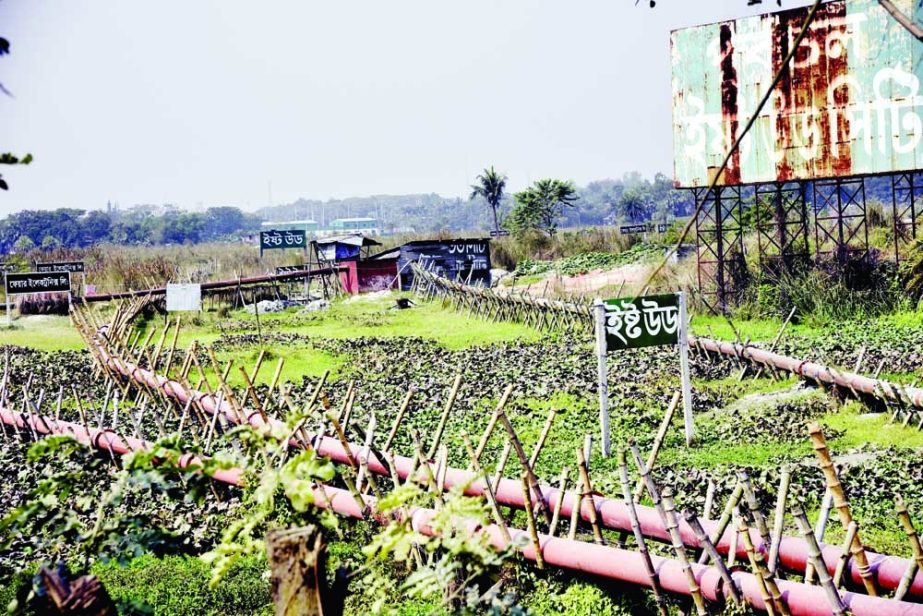
Anisur Rahman Khan :
About 12 years have gone, but the land ministry failed to finalise the “Agricultural Use and Land Zoning Act 2010” to protect country’s multi-crop lands.
As a result, it is threatening food security and putting the environment in great peril, which land sharks across the country are busy developing plots for housing projects by filling up multi-crop farmlands and wetland areas due to absence of such law.
Farmlands and wetlands around the four rivers — Turag, Buriganga, Balu and Shitalakhya — are being occupied by different housing developer companies. Some of these companies are renting space for raising their signboards and often disappearing after collecting money from advance sales to unsuspecting customers.
The country’s current population growth rate is 1.42 per cent, with population over 16 crore, while the share of agricultural land has decreased by 1 per cent annually, statistics show.
Most of the farmlands on different road sides in Munshiganj, Narayanganj, Gazipur, Tangail, Mymensingh, Narsingdi and Dhaka districts are occupied by these developers.
Land, in a densely populated country like Bangladesh, is becoming scarce, not only because of population rise, but also due to setting up of unplanned industrial units, housing projects, and river erosion.
Besides, shady operators, all over the country, keep grabbing wetlands and also erecting structures, further reducing the country’s limited fertile farmlands, leaving the deltaic nation vulnerable to climate change.
According to a study conducted by Soil Resource Development Institute (SRDI) in 2013, agricultural land included cropland, forest, mangrove forest, river, lake (Kaptai), beel and haor, tea estate and salt pan. The area under agricultural land was 13303654ha which 91.83 percent of the country was in 1976.
This agricultural land has been decreased to 12742274ha with the annual loss of 23391ha in 2000 and again with annual loss of 56537ha it reaches to 12176904ha in 2010.
The annual loss of agricultural land during the study period (1976-2010) was 33140ha. This indicates that the availability of agricultural land was in decreasing trend with much faster during the period from 2000 to 2010.
All this is going on in spite of a government initiative to formulate the “Agricultural Land Protection and Land Zoning Act 2010.”
However, recently, the Law Commission of Bangladesh has published a draft legislation called ‘Bangladesh Land Act 2020’ on its website seeking opinion from all.
According to Dr MA Bari, chief scientific officer of the Soil Research Development Institute (SRDI), 68,700 hectares of farmlands have been converted into non-agricultural land annually since 2000.
“We have limited lands. It won’t be possible to achieve SDG goal to doubled the country’s product mainintaining nutritious safe food by 2030 if croplands are decreased,” he said in reply to a query.
Climate change has turned Bangladesh into one of the most vulnerable countries and, to make matters worse, a group of unscrupulous people were constructing housing complexes on farmlands after grabbing them by dumping wastes, including untreated industrial wastes, said the SRDI chief scientific officer.
When contacted Additional Secretary of the Land Ministry Prodip Kumar Das, said, “We have already completed land zonning plan in Union Parishad (UP) and Upazila level. Now the project has expanded and we are working to make a map plotwise.”
After completion of zonning map the government will decide which lands will be used for housing and agricultural purposes, he said.
Farmlands, wetlands and canals were being filled up by a section of people, Deputy commissioner of Gazipur district Anisur Rahman told The New Nation and added they are applying law strictly to stop such acitivities.
“Many people changes their classes of lands after selling. We have instructed the land officials to check it during mutation. It would be possible to stop changes of classes of lands that which lands are sold,” he said.
“If this trend goes on, we will lose more arable lands. However, we have already informed the higher authorities about the problem and sought immediate action against the wrongdoers,” an official at the Gazipur Department of Agricultural Extension (DAE) said.
Abdus Sobhan, former additional director general of the Department of Environment (DOE) and now a green activist, noted: “It is high time we protect our farmlands by formulating a land use zone to ensure food security.”
“Bangladesh is a densely populated country. At least 130 km of canals have disappeared at Sonargaon in Narayanganj district. While 33 per cent canals & rivers and 52 per cent wetlands in Dhaka district alone, have already been grabbed. Real estate developers are out to make money by developing these lands for housing projects and thus endangering national food security,” the green activist said.
“No one will be allowed to set up any industries or housing projects on wetlands and farmlands. Taking a no-objection certificate (NOC) of the DoE is mandatory before setting up such units,” Dr. Abdul Hamid, Director General of the DoE, told The New Nation on Saturday.
Related laws will be applied to protect the country’s environment and ecology, the newly appointed head of the DoE said, adding that the DoE has already fined a number of realtors, brick kiln, and factory owners, in Munshiganj, Narayanganj, Savar and Gazipur areas, for setting up their businesses on valuable multi-crop farmland and wetlands, without any NOC from the DoE.
Most of the encroachers and developers have grabbed wetlands, after changing the land records in cahoots with corrupt land department employees, and showing such land as agricultural or fallow land, multiple sources said to this correspondent.
Bangladesh had 9 million hectares of farmland in 1980, which has shrunk to about 6 million hectares in 2012, experts said.
The decline in farm land available needs to be stopped, not only to ensure food security, but also to create jobs, to accelerate the pace of poverty reduction.

